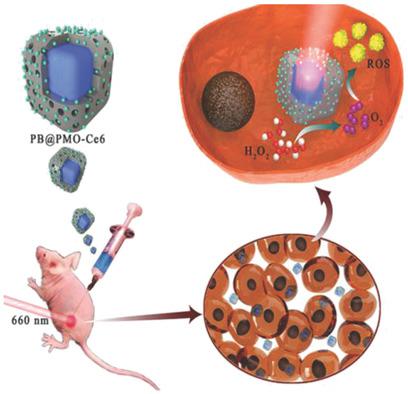Our official English website, www.x-mol.net, welcomes your
feedback! (Note: you will need to create a separate account there.)
Oxygen‐Evolving Mesoporous Organosilica Coated Prussian Blue Nanoplatform for Highly Efficient Photodynamic Therapy of Tumors
Advanced Science ( IF 14.3 ) Pub Date : 2018-02-22 , DOI: 10.1002/advs.201700847 Zhen Lu Yang 1 , Wei Tian 2 , Qing Wang 3 , Ying Zhao 1 , Yun Lei Zhang 1 , Ying Tian 1 , Yu Xia Tang 1 , Shou Ju Wang 1 , Ying Liu 1 , Qian Qian Ni 1 , Guang Ming Lu 1, 4 , Zhao Gang Teng 1, 4 , Long Jiang Zhang 1
Advanced Science ( IF 14.3 ) Pub Date : 2018-02-22 , DOI: 10.1002/advs.201700847 Zhen Lu Yang 1 , Wei Tian 2 , Qing Wang 3 , Ying Zhao 1 , Yun Lei Zhang 1 , Ying Tian 1 , Yu Xia Tang 1 , Shou Ju Wang 1 , Ying Liu 1 , Qian Qian Ni 1 , Guang Ming Lu 1, 4 , Zhao Gang Teng 1, 4 , Long Jiang Zhang 1
Affiliation

|
Oxygen (O2) plays a critical role during photodynamic therapy (PDT), however, hypoxia is quite common in most solid tumors, which limits the PDT efficacy and promotes the tumor aggression. Here, a safe and multifunctional oxygen‐evolving nanoplatform is costructured to overcome this problem. It is composed of a prussian blue (PB) core and chlorin e6 (Ce6) anchored periodic mesoporous organosilica (PMO) shell (denoted as PB@PMO‐Ce6). In the highly integrated nanoplatform, the PB with catalase‐like activity can catalyze hydrogen peroxide to generate O2, and the Ce6 transform the O2 to generate more reactive oxygen species (ROS) upon laser irradiation for PDT. This PB@PMO‐Ce6 nanoplatform presents well‐defined core–shell structure, uniform diameter (105 ± 12 nm), and high biocompatibility. This study confirms that the PB@PMO‐Ce6 nanoplatform can generate more ROS to enhance PDT than free Ce6 in cellular level (p < 0.001). In vivo, the singlet oxygen sensor green staining, tumor volume of tumor‐bearing mice, and histopathological analysis demonstrate that this oxygen‐evolving nanoplatform can elevate singlet oxygen to effectively inhibit tumor growth without obvious damage to major organs. The preliminary results from this study indicate the potential of biocompatible PB@PMO‐Ce6 nanoplatform to elevate O2 and ROS for improving PDT efficacy.
中文翻译:

释氧介孔有机硅涂层普鲁士蓝纳米平台用于肿瘤的高效光动力治疗
氧气(O 2)在光动力治疗(PDT)过程中起着至关重要的作用,然而,缺氧在大多数实体瘤中相当常见,这限制了PDT的疗效并促进了肿瘤的侵袭。在这里,构建了一个安全且多功能的析氧纳米平台来克服这个问题。它由普鲁士蓝 (PB) 核和二氢卟酚 e6 (Ce6) 锚定的周期性介孔有机二氧化硅 (PMO) 壳(表示为 PB@PMO-Ce6)组成。在高度集成的纳米平台中,具有类过氧化氢酶活性的PB可以催化过氧化氢产生O 2,而Ce6在激光照射下将O 2转化为产生更多的活性氧(ROS)用于PDT。该PB@PMO-Ce6纳米平台具有明确的核壳结构、均匀的直径(105±12 nm)和高生物相容性。这项研究证实,在细胞水平上,PB@PMO-Ce6 纳米平台可以比游离 Ce6 产生更多的 ROS 来增强 PDT(p < 0.001)。在体内,单线态氧传感器绿色染色、荷瘤小鼠的肿瘤体积和组织病理学分析表明,这种释氧纳米平台可以升高单线态氧,从而有效抑制肿瘤生长,而不会对主要器官造成明显损害。本研究的初步结果表明生物相容性PB@PMO-Ce6纳米平台具有提高O 2和ROS以提高PDT疗效的潜力。
更新日期:2018-02-22
中文翻译:

释氧介孔有机硅涂层普鲁士蓝纳米平台用于肿瘤的高效光动力治疗
氧气(O 2)在光动力治疗(PDT)过程中起着至关重要的作用,然而,缺氧在大多数实体瘤中相当常见,这限制了PDT的疗效并促进了肿瘤的侵袭。在这里,构建了一个安全且多功能的析氧纳米平台来克服这个问题。它由普鲁士蓝 (PB) 核和二氢卟酚 e6 (Ce6) 锚定的周期性介孔有机二氧化硅 (PMO) 壳(表示为 PB@PMO-Ce6)组成。在高度集成的纳米平台中,具有类过氧化氢酶活性的PB可以催化过氧化氢产生O 2,而Ce6在激光照射下将O 2转化为产生更多的活性氧(ROS)用于PDT。该PB@PMO-Ce6纳米平台具有明确的核壳结构、均匀的直径(105±12 nm)和高生物相容性。这项研究证实,在细胞水平上,PB@PMO-Ce6 纳米平台可以比游离 Ce6 产生更多的 ROS 来增强 PDT(p < 0.001)。在体内,单线态氧传感器绿色染色、荷瘤小鼠的肿瘤体积和组织病理学分析表明,这种释氧纳米平台可以升高单线态氧,从而有效抑制肿瘤生长,而不会对主要器官造成明显损害。本研究的初步结果表明生物相容性PB@PMO-Ce6纳米平台具有提高O 2和ROS以提高PDT疗效的潜力。











































 京公网安备 11010802027423号
京公网安备 11010802027423号